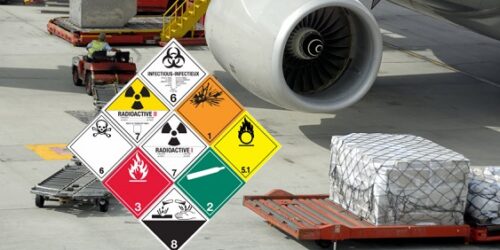CIFFA Exam Sample Practice Questions and Answers – Air Freight

CIFFA Exam Sample Practice Questions and Answers – Air Freight
Questions
- What is CASS and what is its purpose?
- Define MAWB (master air waybill) and HAWB (house air waybill) and their function.
- Why are labelling and marking important?
- What should a label for air freight show?
- What is a shipper’s letter of instruction (SLI) and why is it important?
- Is an air waybill a negotiable document?
- What are some of the functions of an air waybill?
- How do you send out documents to your agent for an air freight shipment?
- When and why would you complete the declared value for carriage box in the air waybill?
- When would you complete the declared value for customs box in the air waybill?
- What is meant by a shipment delivered ready for carriage to the airline?
- What is TACT?
- What is a specific commodity rate?
- What are the maximum advanced charges that can be added on to the collect air freight charges on the AWB?
- What is meant by low-density cargo?
- What does GCR stand for?
- Which convention does air freight carrier’s liability fall under? What amount is the carrier liable for in the case of a claim?
- Can you obtain a higher liability? How?
What is a ULD?
- What is meant by pivot weight?
- What does the acronym IATA mean?
- What is meant by chargeable weight?
- Decode the following three-letter airport codes.
YYZ:
YUL:
YVR:
LHR:
HKG:
AMS:
LGA:
LAX:
ATL:
ORD:
- What agency regulates air cargo security in Canada?
- What organization developed recommendations for maritime security?
- What organization developed recommendations for air security?
- What is the main goal of Transport Canada’s Air Cargo Security Program?
- Under which Canadian government Act does air cargo security fall?
- What does the acronym SMRAC mean?
- What does the acronym CSC mean, and what is their main responsibility?
- What does the acronym ACR mean, and what is their main responsibility?
- What (where) are the key gateway hub airports for Canada and the USA (and their 3-letter codes) on this map?
- What are the major international airports for Europe (and their 3-letter codes) on this map?
- What are the major international airports for Asia (and their 3-letter codes) on this map?
Container Requirements and Loading Calculations
Shippers and freight forwarders are continually looking for ways to save costs. One of the ways in which to do this is by containerizing or unitizing cargo.
By consolidating many shipments into one, then loading them into aircraft containers/unit load devices(ULDs), the shipper or freight forwarder can benefit from 2 cost savings: consolidating cargo, and loading the cargo into a ULD themselves. Airlines may provide preferential rates for “shipper loaded” ULDs.
Note: Refer to Appendices “B,” “E,” and “F” for conversion tables, weight/volume ratio and ULD dimensions and maximum payload.
Estimating Example
Note: For this assignment, the max. net weight of LD7 pallet is 10,000 lb (4,536 kg) and the max. volume is 408 ft3 (11.5 m3).
- A customer has 15 crates of auto parts and 150 cartons of brochures, total shipment volume is 803.4 ft3, total shipment weight is 27,000 lb. Only LD7 pallets are available for this aircraft/flight. How many LD7 containers are required to move this shipment?
Actual Calculation
- Using previous estimating example, we have asked the customer what the crate and carton sizes are. The customer tells you that each of the 15 crates is 46 in x 38 in x 38 in, and each of the 150 cartons is 18 in x 12 in x 12 in. Each crate has a weight of 1,500 lb, and each carton has a weight of 30 lb. We have previously estimated that the customer requires 3 x LD7 pallets. Now we can mathematically determine if our customer’s freight fits into 3 x LD7 pallets.
Container Loading Plan
- Shipment details:
36 wooden crates of machinery
Each wooden crate is 40 in L x 20 in W x 20 in H
Each wooden crate is 700 lb.
a) Estimate the number of LD7 pallets required to move this shipment in the most efficient manner, based on weight.
b) Estimate the number of LD7 pallets required to move this shipment in the most efficient manner, based on volume.
c) Complete a container loading plan to show the exact number of LD7 pallets required to move this shipment in the most efficient manner.
- Shipment details:
Shipment 1:
12 skids of printed matter
Each skid is 105 cm L x 100 cm W x 120 cm H
Each skid is 500 kg.
Shipment 2:
32 cartons of clothing
Each carton is 120 cm L x 75 cm W x 50 cm H
Each carton is 10 kg.
a) Estimate the number of M1 pallets required to move this consolidation in the most efficient manner, based on weight.
b) Estimate the number of M1 pallets required to move this consolidation in the most efficient manner, based on volume.
c) Complete a container loading plan to show the exact number of M1 pallets required to move this consolidation in the most efficient manner.
Answers
- What is CASS and what is its purpose?
Cargo Accounts Settlement System allows the air carrier to obtain payment directly from the bank account of the air forwarder. The reporting and payment are done twice per month.
- Define MAWB (master air waybill) and HAWB (house air waybill) and their function.
MAWB – “contract of carriage;” document used for the dispatch of a consolidation or an individual shipment. Rates shown on the MAWB are according to the TACT rates.
HAWB – “contract of carriage;” document used by the air freight forwarder to identify the individual shipment for each client. The rates shown on the HAWB are determined by the air freight forwarder either on a prepaid or collect basis.
- Why are labelling and marking important?
The risk of a split shipment is higher in air cargo. The labelling and marks will help identify the shipment.
- What should a label for air freight cargo show?
MAWB #, destination, # pieces, weight of each piece, weight of the total shipment, transfer stations, handling information, HAWB#.
- What is a shipper’s letter of instruction (SLI) and why is it important?
The SLI is an itemized list giving all the details required for the completion of the air waybill. The use of the SLI will ensure that the shipper’s instructions are complete and will avoid having you obtain additional information from the client for acceptance of the shipment and issuance of the air waybill.
A very important legal aspect of this document is that by signing it, the shipper does two things: 1. Authorizes his agent (the freight forwarder) to prepare and sign the air waybill on his behalf. 2. Certifies that the contents of the consignment are properly identified by name, commodity, weight, etc.
- Is an air waybill a negotiable document?
No, a contract of carriage ONLY.
- What are some of the functions of an air waybill?
Contract of carriage, contract of receipt, information sheet, insurance request and a customs declaration.
- How do you send out documents to your agent for an air freight shipment?
In an envelope attached behind the MAWB.
- When and why would you complete the declared value for carriage box in the air waybill?
You would enter the value of the shipment when you want the carrier to assume a greater liability for the goods. By declaring a value for carriage, carrier may assess valuation charges.
When no value is declared, NVD (no value declared) shall be entered.
- When would you complete the declared value for customs box in the air waybill?
When the AWB is also acting as a customs declaration in the evaluation of import duties. When no value is declared, NCV (no commercial value) may be entered OR the box may be left blank.
- What is meant by a shipment delivered ready for carriage to the airline?
The air waybill is completed, the additional documents are attached in an envelope and the shipment is properly packed with the marks and proper air waybill labels are affixed to the cargo.
- What is TACT?
The Air Cargo Tariff, the airlines’ rates and rules.
- What is a specific commodity rate?
Rate for named commodities moved between named cities.
- What are the maximum advanced charges that can be added on to the collect air freight charges on the AWB?
Not more than the air freight charges as long as the goods have a sound commercial value.
- What is meant by low-density cargo?
Weight is charged per volume instead of actual weight, i.e., bulky cargo. Cargo will be referred to as “volume cargo” when the cargo surpasses the volume weight formula of 6,000 cm3/kg.
- What does GCR stand for?
General Cargo Rate.
- Which convention does air freight carrier’s liability fall under? What amount is the carrier liable for in the case of a claim?
Under the Warsaw Convention, the carrier’s liability is limited to USD $20.00/kg, chargeable weight.
Under the Montreal Protocol, the carrier’s liability is set at SDR 19.00/kg, chargeable weight.
- Can you obtain a higher liability? How?
Yes, declare value on the AWB, in the declared value for carriage box.
- What is a ULD?
Unit load device, an airline container, or platform.
- What is meant by pivot weight?
The minimum chargeable ULD weight. Weights in excess of the pivot weight may result in additional charges being applied by the carrier.
- What does the acronym IATA mean?
International Air Transport Association.
- What is meant by chargeable weight?
It is the higher of the actual vs. volume weights of the shipment.
- Decode the following three-letter airport codes.
YYZ: Toronto Pearson; YUL: Montreal Trudeau; YVR: Vancouver; LHR: London Heathrow; HKG: Hong Kong; AMS: Amsterdam Schiphol; LGA: New York La Guardia; LAX: Los Angeles; ATL: Atlanta Hartsfield; ORD: Chicago O’Hare.
- What agency regulates air cargo security in Canada?
Transport Canada.
- What organization developed recommendations for maritime security?
IMO.
- What organization developed recommendations for air security?
ICAO.
- What is the main goal of Transport Canada’s Air Cargo Security Program?
To secure the supply chain.
- Under which Canadian government Act does air cargo security fall?
The Aeronautics Act.
- What does the acronym SMRAC mean?
Security Measures Respecting Air Cargo.
- What does the acronym CSC mean, and what is their main responsibility?
Cargo Security Coordinator – a person with overall responsibility for air cargo security at a forwarder’s location.
- What does the acronym ACR mean, and what is their main responsibility?
Authorized Cargo Representative – a person who has control of or physical access to air cargo.
- What are the key gateway hub airports for Canada and the USA (and their 3-letter codes) on this map?

- What are the major international airports for Europe (and their 3-letter codes) on this map?

- What are the major international airports for Asia (and their 3-letter codes) on this map?

Container Requirements and Loading Calculations
Estimating Example
Note: For this assignment, the max. net weight of LD7 pallet is 10,000 lb (4,536 kg) and the max. volume is 408 ft3 (11.5 m3).
- A customer has 15 crates of auto parts and 150 cartons of brochures, total shipment volume is 803.4 ft3, total shipment weight is 27,000 lb. Only LD7 pallets are available for this aircraft/flight. How many LD7 containers are required to move this shipment?
You know that the volume of the shipment is 803.4 ft3, and the average volume capacity of an LD7 pallet is 408 ft3. Therefore, we ESTIMATE we need 2 x LD7 pallets to move this shipment (803.4 ft3 408 ft3 max per LD7 = 1.9 = 2 x LD7 pallets).
Let’s check the weights. The actual total weight of the shipment is 27,000 lb, which EXCEEDS the payload capacity of 2 x LD7 pallets (10,000 lb x 2 LD7 pallets = 20,000 lb). Therefore, we ESTIMATE we will need 3 x LD7 pallets to move this shipment, as the total shipment weight of 27,000 lb is within the payload capacity of 3 x LD7 pallets (10,000 lb x 3 LD7 pallets = 30,000 lb).
Therefore, the number of LD7 pallets required by both the volume calculations and the weight calculations do NOT match. What do we do? We must use the higher number, therefore we will need 3 x LD7 pallets to move this shipment. We CANNOT exceed the maximum weight capacity of the pallet.
Therefore, since the cargo fits into the volume and weight capacities of 3 x LD7 pallets, our ESTIMATE of 3 x LD7 pallets to move this shipment seems feasible.
Note: The above examples are ESTIMATES only. In order to determine the actual number of containers required, you need the exact dimensions of the shipment, and then devise a container loading plan.
Ensure you let the customer know these are ESTIMATES ONLY.
Actual Calculation
- Using previous estimating example, we have asked the customer what the crate and carton sizes are. The customer tells you that each of the 15 crates is 46 in x 38 in x 38 in, and each of the 150 cartons is 18 in x 12 in x 12 in. Each crate has a weight of 1,500 lb, and each carton has a weight of 30 lb. We have previously estimated that the customer requires 3 x LD7 pallets. Now we can mathematically determine if our customer’s freight fits into 3 x LD7 pallets.
ALWAYS start with the largest/heaviest cargo. Then fill up any remaining space with the smaller/lighter cargo.
Divide the length, width, and height of the shipment into the length, width, and height of the chosen container.
L x W x H pallet: 125 x 88 x 64
L x W x H crate: 46 38 38
= 2.7 x 2.3 x 1.7
= 2 x 2 x 1
= 4
This tells us we can load 4 crates on 1 x LD7 pallet.
Is there a more efficient way to load our customer’s freight?
One key point that should be looked at is – does the length plus the width of the crate add up to 88 in, which is the width of a LD7 pallet? Whenever the length plus width of a crate add up to 88 in (or close to it), the “lights” should go on. 88 is a magical number whenever we are dealing with an LD7 pallet. Is there a way that we can “turn” and interlock the pallets such that we utilize the entire 88 in of width?
Note: There are different “magical” numbers for each type of container and each dimension on those containers.
Looking at this top-down drawing, we can see that by turning one pallet and placing it beside the first, we can interlock the pallets and utilize almost the entire 88 in of the pallet width.
By loading in this manner, we see that for every 84 in of floor length used, we can load 4 pallets on the floor.
By maximizing the efficiency of loading these crates, we can now get 5 crates per LD7 pallet. Since we are shipping 15 crates, we need a total of 3 x LD7 pallets.
Now we need to load the remaining cartons of brochures. We have 1 space on the pallet left to load, 41 in (125 in length of pallet – 38 in – 46 in = 41 in) x 42 in (88 in width of pallet – 46 in crate = 42 in).
L x W x H remaining space on pallet: 42 x 41 x 64
L x W x H carton: 18 12 12
= 2.3 x 3.4 x 5.3
= 2 x 3 x 5
= 30
This tells us we can load 30 cartons in the remaining space on 1 x LD7 pallet.
However, we also have room on top of the 5 crates in which to load additional cartons. The remaining space above the group of 4 interlocked crates is 84 in x 84 in x 26 in (64 in pallet height – 38 in crate height = 26 in).
L x W x H remaining space on top of crates: 84 x 84 x 26
L x W x H Carton: 18 12 12
= 4.7 x 7 x 2.2
= 4 x 7 x 2 = 56
This tells us we can load 56 cartons in the remaining space on top of the group of 4 crates.
In this case, we are not tight for space, so to equal out the shipment amongst all 3 x LD7 pallets, we will only load 50 cartons on each LD7 pallet.
3 cartons long x 2 cartons wide x 5 layers high = 30 cartons
3 cartons long x 2 cartons wide x 5 layers high = 30 cartons
5 cartons long x 4 cartons wide x 1 layer high = 20 cartons
Let’s verify the weights to ensure we are not over the capacity of an LD7 pallet:
5 crates x 1,500 lb = 7,500 lb
50 cartons x 30 lb = 1,500 lb
TOTAL per LD7 pallet = 9,000 lb
This is within the capacity of 1 x LD7 pallet (max is 10,000 lb).
Now we have confirmed that the dimensions and weights for this shipment are within the capacities of 3 x LD7 pallets.
Container Loading Plan
Note: There are other alternatives to the above, but generally use the KISS Principle (Keep It Short and Simple). Start with the heaviest/largest cargo, spread the load amongst all containers, and then fill the remaining space equally with the rest of the cargo. The above container loading plan is the simplest, as it spreads the cargo evenly amongst all 3 x LD7 pallets.
Container Loading Plan
Shipment details:
36 wooden crates of machinery
Each wooden crate is 40 in L x 20 in W x 20 in H
Each wooden crate is 700 lb.
a) Estimate the number of LD7 pallets required to move this shipment in the most efficient manner, based on weight.
36 wooden crates x 700 lb = 25,200 lb total net weight.
25,200 lb total net weight ÷ 9,000 lb maximum net weight per LD7
= 3 LD7s.
b) Estimate the number of LD7 pallets required to move this shipment in the most efficient manner, based on volume.
(36 wooden crates x 40 in L x 20 in W x 20 in H ) ÷ 1,728
= 576,000 in3 ÷ 1,728 = 334 ft3 total volume.
334 ft3 total volume ÷ 380 ft3 maximum volume per LD7 = 1LD7.
c) Complete a container loading plan to show the exact number of LD7 pallets required to move this shipment in the most efficient manner.
Shipment details:
Shipment 1:
12 skids of printed matter
Each skid is 105 cm L x 100 cm W x 120 cm H
Each skid is 500 kg.
Shipment 2:
32 cartons of clothing
Each carton is 120 cm L x 75 cm W x 50 cm H
Each carton is 10 kg.
a) Estimate the number of M1 pallets required to move this consolidation in the most efficient manner, based on weight.
12 skids x 500 kg = 6,000 kg total net weight of shipment #1.
32 cartons x 10 kg = 320 kg total net weight of shipment #2.
6,000 kg + 320 kg = 6,320 kg total net weight ÷ 4,978 kg maximum net weight per M1 = 2 M1s.
b) Estimate the number of M1 pallets required to move this consolidation in the most efficient manner, based on volume.
(12 skids x 105 cm L x 100 cm W x 120 cm H) ÷ 1,000,000 = 15,120,000 cm3 ÷ 1,000,000 = 15.12 m3 total volume of shipment #1.
(32 cartons x 120 cm L x 75 cm W x 50 cm H) ÷ 1,000,000 = 14,400,000 cm3 ÷ 1,000,000 = 14.4 m3 total volume of shipment #2.
15.12 m3 + 14.4 m3 = 29.52 m3 total volume ÷ 16.16 m3 maximum volume per M1 = 2 M1s.
c) Complete a container loading plan to show the exact number of M1 pallets required to move this consolidation in the most efficient manner.





